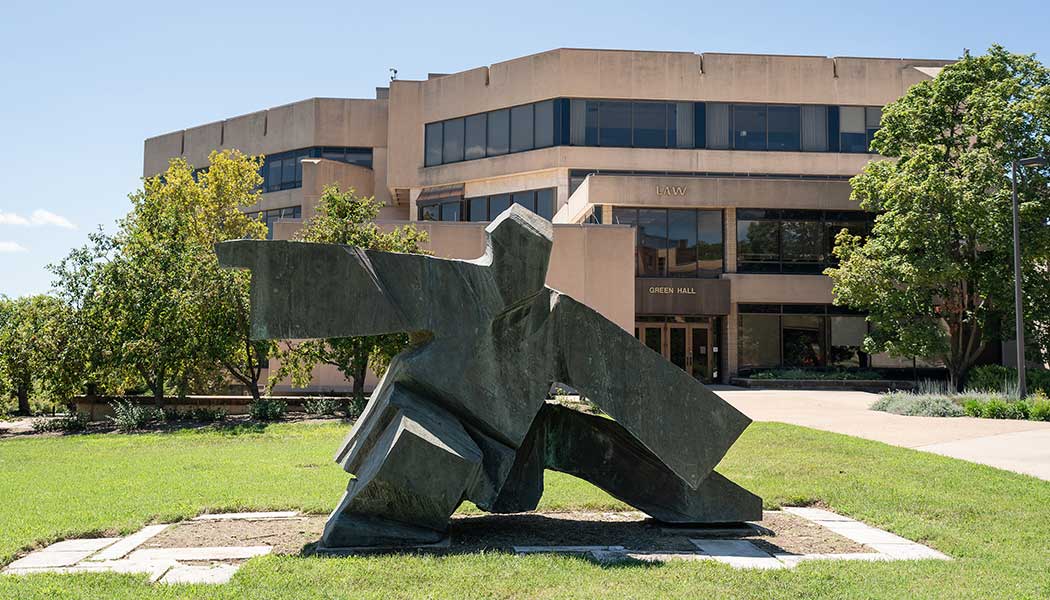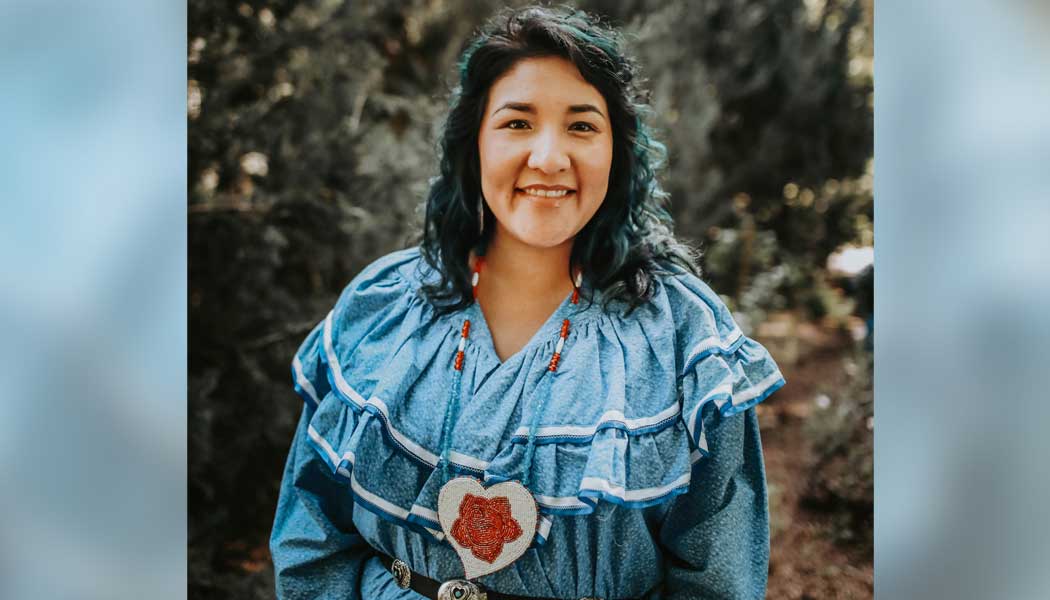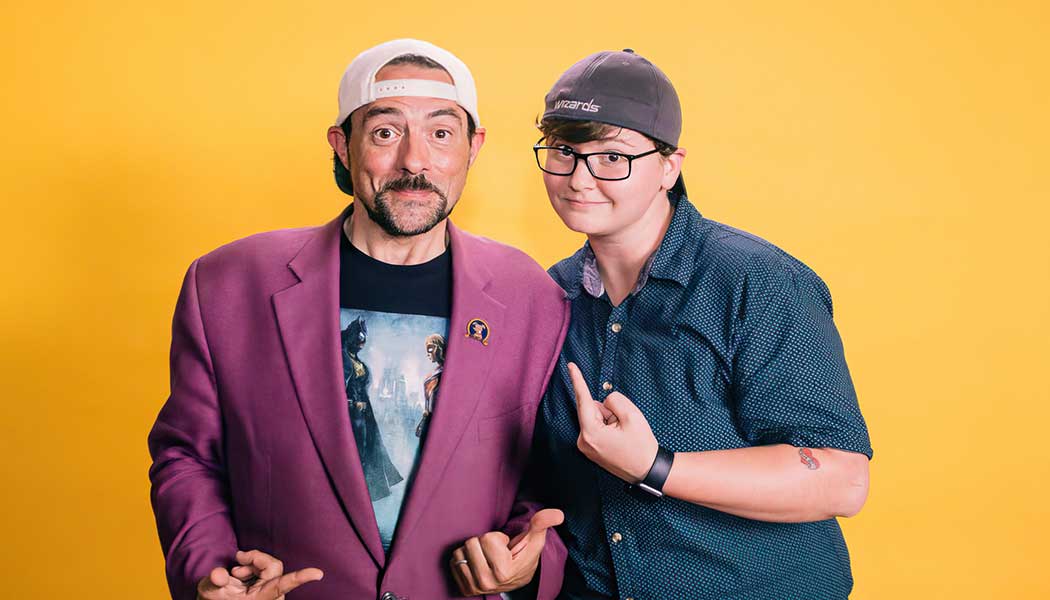The translator: Cynthia Bryant of The Seeing Eye
Issue 1, 2024
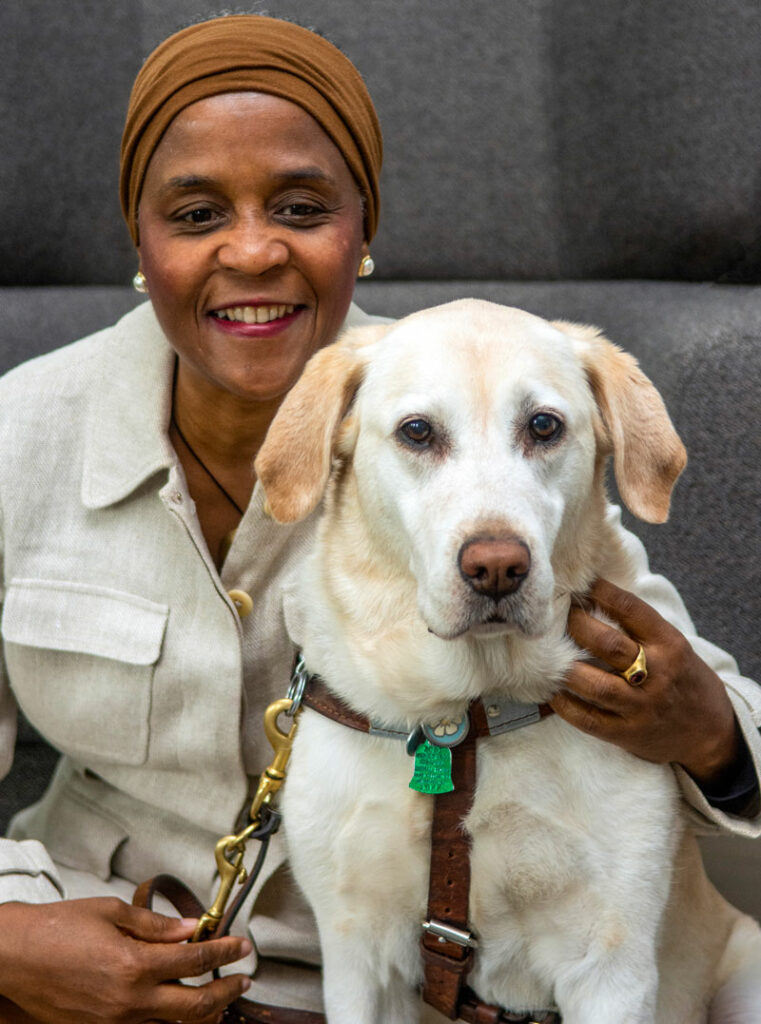
Cynthia Bryant is accustomed to the questions. She hears them while waiting to cross a street, when she enters an elevator, and in other moments as she negotiates—with the help of Summer, her guide dog—crowded public spaces that most people pass through without much thought.
The phrasing can range from diplomatic to blunt, but most who ask are curious about the same thing: How can a person who has little or no access to a sense that is said to account for 80% of human perception move with such apparent ease, even with the help of a trained dog?
Since retiring in December 2022 from a two-decade career as a lawyer with the Federal Communications Commission, Bryant, l’95, has built a consulting practice that draws on her work as a professional mediator. She also completed the first year of her term as chair of the board of trustees at The Seeing Eye, a school in Morristown, New Jersey, that trains dogs to guide blind people and instructs its blind students in the care and handling of their canine companions. Bryant is the first graduate of The Seeing Eye training program (and the first woman of color) to lead the board of the nonprofit organization, which annually serves about 260 people who are blind or visually impaired and has fostered more than 18,000 partnerships between people and their Seeing Eye dogs since its founding in 1929.
The travel associated with both roles requires her to navigate busy airports, hotels and streets in unfamiliar cities. But the questions can also come when she’s strolling her own neighborhood in Chevy Chase, Maryland. While she may be used to hearing them, they can sometimes take her aback.
Once, while attending a conference, she entered an elevator with Summer and pushed the button for her floor.
“The door closes, and there’s a woman in the elevator with me,” Bryant recalls. “And she says, ‘You need sight to move like that, don’t you?’”
Bryant explained that she has some light perception, but not much sight, and assured the woman that people who are totally blind can function quite well with the help of a trained dog.
“I could have been offended. But there’s a part of you that says, this is a question. You need to be patient. Rather than shut the person down, you need to answer, because that sends the person away with a nugget of knowledge that they can carry forward,” Bryant says.
“When you’re a guide-dog handler, you become a kind of unofficial ambassador for the rest of the community,” says Michelle Barlak, spokesperson for The Seeing Eye. “When our graduates get their first guide dog, we do a lot to prepare them for that, because it’s something they’re not used to. Graduates often tell us they felt invisible before they had a guide dog, so it is a big adjustment to suddenly be the person in the room with the dog that everybody wants to know about. Cynthia is just so gracious in taking the time to speak with members of the public who have questions. She sees it as an opportunity to represent other guide-dog users. On a larger scale, she’s also representing other people with disabilities and really helping to bridge that gap between people who live in this world and work with guide dogs every day and those who maybe don’t understand what it is the dogs and the graduates are trained to do.”
That equanimity is rooted in Bryant’s training and her professional work in mediation and negotiation, in her family upbringing, and in her life experience as a woman and an African American. Most of all, it is rooted in her experience with blindness.
“It’s interesting for me as someone who is female, someone who is African American, and someone who is blind, that my greatest challenge is my disability,” Bryant said during a 2021 conversation with Eksteen De Waal on his “Exponential Leadership” podcast. “Race doesn’t require as much patience as disability. Disability crosses all spectrums.”
Bryant was diagnosed with retinitis pigmentosa as an adolescent growing up in south Kansas City. A group of rare eye diseases that affect the light-sensitive area at the back of the eye, RP is a genetic condition that causes cells in the retina to break down over time, starting with a loss of peripheral and night vision. When she arrived at KU, after graduating from Bradford College in Massachusetts and working several years as an early childhood and music educator, Bryant’s vision had deteriorated to the point that she needed assistive technology when she entered the School of Law. She was 29 years old.
After law school, Bryant joined the Missouri Public Service Commission, the agency that regulates the state’s utilities and telecommunications providers. She was drawn by a fascination with administrative law, regulatory policy and mediation that she discovered while studying at KU.
A memory from childhood, however, suggests the seed of that interest may have been planted long before law school.
Watching TV at around 10 years old, Bryant saw news coverage of two heads of state conferring. What enthralled her wasn’t the world leaders, but the person between them: a translator, dressed all in black, hair pulled back in a ponytail. “I was just fascinated by this person in the middle that bridged them,” Bryant recalls. “How that person could switch languages and talk to one and then the other, and how, because of the translator, the two leaders could talk to each other. That was the earliest time I can remember that I liked that concept of bridging people. That was the first time that I thought, ‘That person in the middle is fascinating.’ And I wouldn’t have had that, had my mother not exposed me to things.”
Her mother, Rose Bryant, is a chemist who has long been involved with arts and culture organizations, most recently as a member of the National Advisory Board at KU’s Spencer Museum of Art. Her father, TJ Bryant, m’63, who died in 2008, was a doctor who graduated from the School of Medicine. Cynthia Bryant says that when she was growing up in Kansas City in the 1960s, the African American community had two approaches to dealing with the formal and informal policies that dictated where Black families should and should not live.
“One is to stay in the African American community and economically boost that area, which is positive and works well, and which many African Americans did,” she says. “And then there was the mindset of, ‘Well, let’s penetrate this. The laws allow us to buy in the areas that offer our children opportunities.’ So that’s the route that my parents took—to get in the mix.”
Bryant and her two older brothers attended a Jewish day camp and went to Catholic schools. The family saw the first neighborhood they lived in transformed by white flight; later, they had a seller take a house off the market when they tried to buy in a different part of town. They kept looking, and the neighborhood they moved to when Bryant was 7 was “overwhelmingly welcoming,” she recalls—though not unanimously so. “Did our house get egged and all that? Yeah, it did,” she says. “Was a BB shot through the window? Yes, through my bedroom window. So of course my father was on high alert, because this was his child’s window. But we moved in, and we were welcomed by most.”
Adds Bryant, “My parents’ mindset was always, we’re going to get in this and our children are going to receive an education, and our children are going to learn about others in the community and in the world. That probably is what gave me that desire to learn about others and be as embracing as I am. It’s almost a thirst to really know what others are doing in the world.”
Another question Bryant hears, often posed in a concerned tone that carries a whiff of judgment: Does the dog ever get to play?
Her answer: Yes. Oh, gosh, yes.
Summer is Bryant’s third Seeing Eye dog. (Although often used generically to describe guide dogs trained to assist people with a wide range of visual impairments, the description “Seeing Eye dog” is, in fact, a protected term trademarked by the organization in 1940.) A yellow Labrador/golden retriever cross, Summer answers to a panoply of pet names—Sun-Sun, Baby Girl, Love Bug. Whenever Bryant needs to go somewhere, whether a multiday business trip or just an impromptu run to the corner market for a bag of chips, Summer is on it, ready to work the moment Bryant reaches for the leather-and-steel harness that connects the two when they step out the door.
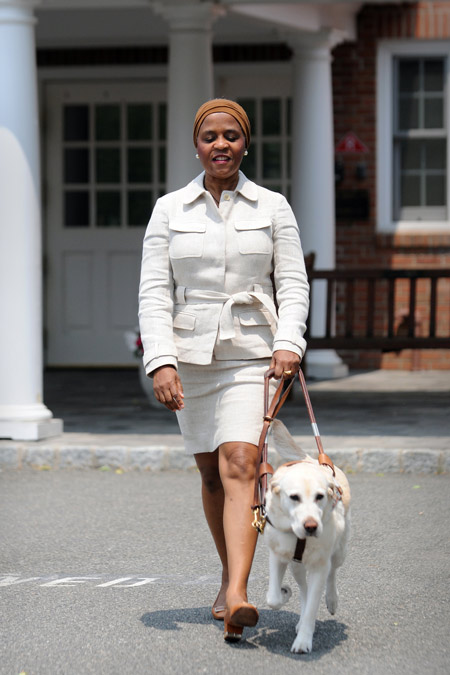
“I try to let people know that when these dogs are in harness, they simply have their business suit on,” Bryant says. We all have our business suits, our work clothes, our Sunday best, she notes—and the comfortable jeans and T-shirt we slip into as soon as we get home. Comportment changes with costume.
“It’s the absolute same for the dog,” Bryant says. “When they’re out of harness, they’re simply a dog in the house. These dogs are loved and cared for more than you know.”
Had Summer not met The Seeing Eye’s rigorous standards to qualify as a guide dog (of the approximately 500 puppies born each year at the organization’s breeding facility, about 60% become guide dogs or are incorporated back into the breeding program), Bryant believes she’d have made a fine Frisbee champ. Like most dogs, Sun-Sun enjoys a good cuddle-and-scratch and a tasty treat. But there is also a bond between the two that goes beyond the usual human-pet connection, Bryant feels.
“We are basically one when we are out together. Even while I’m talking to you now, she is on her bed not far away. There is a devotion that I think is deeper than even a pet. They’re beyond children; they’re beyond spouse.
“There is a deep reliance on me to her and her to me, and that’s necessary when we’re walking around. She has that deep connection to make sure that I am safe. And the reverse is true, too: I have to get to a point where I know she’s going to keep me safe, and I’m not grabbing the harness, pulling her to the side, making it hard on her, but I relax in the harness and hold on with just my fingertips, knowing that we’re good. We’re moving as one, literally connected as one. At this point, when I travel out with her, I have a level of trust with her that I don’t have with a sighted person.”
It wasn’t always so. When Bryant was 8, she went outside to search for her cat, and came face-to-face with a snarling German shepherd named George.
“George was a neighbor’s dog known for biting,” she recalls. The Bryant home had a doorknob-sized hole in the wall of the entry, the result of neighborhood kids frequently flinging open the front door in a mad dash to get inside, away from the dog. “When I called the cat, George came jetting around the corner, his teeth at face-level for an 8-year-old, and I had to run back inside. Luckily I made it.”
The encounter instilled her fear of big dogs that persisted into adulthood. So when a friend who is blind suggested that she consider using a guide dog, she hesitated.
When Bryant made the move to the FCC in Washington, D.C., in 1999, part of the appeal had been the chance to live again in a city with a strong public transit system that would allow her a large measure of freedom and independence. But as her retinitis pigmentosa progressed, she found it harder and harder to navigate the city’s dimly lit subway system with a cane. Getting from point to point took much planning and coordination, and—during the early nightfall of winter—adjusting her work hours to leave the office in time to get home before dark.
She decided to visit The Seeing Eye to learn more about the process of working with a guide dog.
“I remember asking about the dogs’ temperaments, their personalities,” Bryant recalls. “I was very unsure and wanting to know how the dogs are with people. The dog they brought out to meet me was absolutely beautiful, and he just sat there and let me pet him. I was kind of feeling his face and play-handing with his mouth, and I remember saying, ‘Oh, he’s got teeth!’ and the trainer kind of laughed.”
In 2008 Bryant matched with her first guide dog, Royale, a black Labrador/golden retriever cross. Her second dog, Sophia, was a black Labrador. Her partnership with Summer began in 2017.
A speech Bryant gave recently to The Seeing Eye’s Heritage Society donors illustrates just how much her relationship with dogs—guide dogs, in particular—has changed.
As a way of alerting her audience to “the importance of tapping into all of your senses to get a true view of what’s going on around you,” she invited them to join her on a “mental walk” with her and Summer.
Her vivid narration of a morning stroll through her neighborhood brims with sensory detail. The sizzle of bicycle tires on pavement. The sweet scent of a blossoming tree so strong she can taste it. A symphony of birdsong. The tickle of a cool breeze on her skin and the thump of the dog’s wagging tail on her leg. The thrill of momentum and confidence when navigating a tricky passage—“just like when I was a child, and you’re on that bike and you lean in as you take a turn.” Sense by sense, she transforms her singular experience and close partnership with Summer into a language her listeners can understand.

The Seeing Eye’s Barlak recalls that “you could have heard a pin drop. People who have never had to think about what it means to lose your vision, it just doesn’t occur to them how blind people experience the world. So when she gave that description of what it is like to go on a walk with her dog, she was able to tell the story; she was able to translate what she feels and what she hears and how she perceives the world in a really beautiful way.”
Adds Barlak, “A sighted person could never replicate that. So having somebody like Cynthia, who’s such a talented speaker and so good at making that connection with people, is just invaluable to us and helping to make our donors feel that connection to our mission.”
At the FCC, Bryant worked first in the agency’s enforcement division, where she adjudicated consumer complaints against telecommunications carriers, including helping Native American tribes hold the companies to their promise to deliver affordable basic phone service. She enjoyed the process of finding common ground between opposing parties, so she began to focus on mediation, twice attending the Harvard Negotiation Institute to study mediation and negotiation. As part of the leadership program Blacks In Government, she joined the Darlene H. Young Leadership Academy and traveled to Plains, Georgia, to interview former President Jimmy Carter (and, in an unexpected but welcome twist, former first lady Rosalynn Carter) about the negotiating tactics and strategies used to forge the Camp David Accords.
Bryant spent 23 years at the agency, the final stretch as special counsel managing a program that encourages employees to use mediation to resolve workplace conflicts. She also led mediations conducted at other federal agencies in the D.C. area and helped develop training on collaboration and communication for federal employees in hopes of heading off issues before they arose.
Personnel cases often revolved around allegations of age, gender or racial discrimination, and Bryant came to believe that basic differences in personality type and cultural background were often the source of conflicts. It became clear to her, as she talked separately to both sides in disputes, that people really weren’t understanding each other. “We may have the same end game,” she says, “but how we communicate is sometimes on two different planes.”
Many missed connections, she believes, are caused by a tendency to rely too much on what we see when judging others’ intentions. This insight—drawn into even sharper focus by the pandemic-fueled rise of videoconferencing, with its almost obsessive reliance on faces on screens—led her to develop an idea she calls “sensory mindfulness,” a communication strategy that encourages using empathy and deep listening to solve problems.
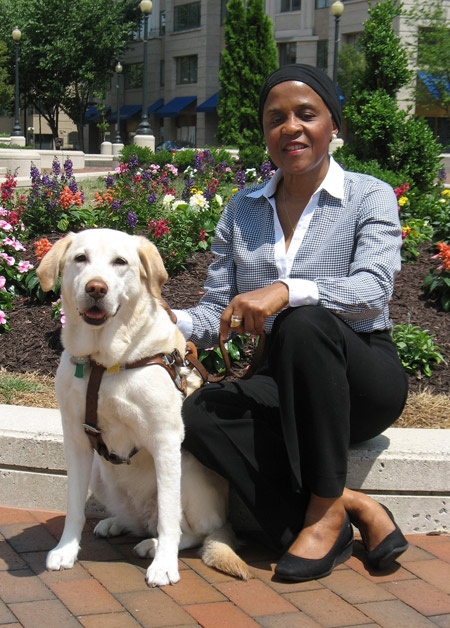
“As a person who has lived in both the sighted world and the blind world, I can reflect on how I perceived others as a sighted person and how I perceive others now as a blind person,” Bryant explains. “Being someone who is blind, and experiencing discrimination here and there, I have come to feel and recognize even more how our eyes can prevent us from coming in close to someone. We view them from a distance, we make an assumption, and that assumption may not be correct. So when I talk about sensory mindfulness, I talk about ways to break down that barrier so that we come in close, we have critical conversations, and we engage with someone. We truly listen to them.”
Truly listening—to what’s being said and what’s not being said—is handy not only for resolving disputes, but also for deciding how to handle personal questions that are not always diplomatically framed.
Another that Bryant has fielded more than once: How’d you get to be like this?
“There was a time I might have said, ‘That’s really inappropriate to ask somebody,’” she says. “But there’s a part of me that has to smile and understand there is more to the question, and it’s not necessarily about me. If I shut the question down, I don’t learn that backstory.”
Nine times out of 10, she finds, the questioner has someone close—a mother, a cousin, a dear friend—who is blind and whom they want to help.
“People don’t necessarily know how to begin,” Bryant says. “I’ve learned that sometimes I need to try to open up the conversation to educate them more about who I am and what I do. And maybe mediation has helped me with that, too. Stay neutral. Try to figure out what’s being said.”
If she can be a bridge between those with sight and those without, between ignorance and understanding, between confusion and enlightenment, she’s willing. It’s what good translators do.
Steven Hill is associate editor of Kansas Alumni magazine.
Top and middle photos courtesy of The Seeing Eye
Bottom photo by Lewis Diuguid
/


